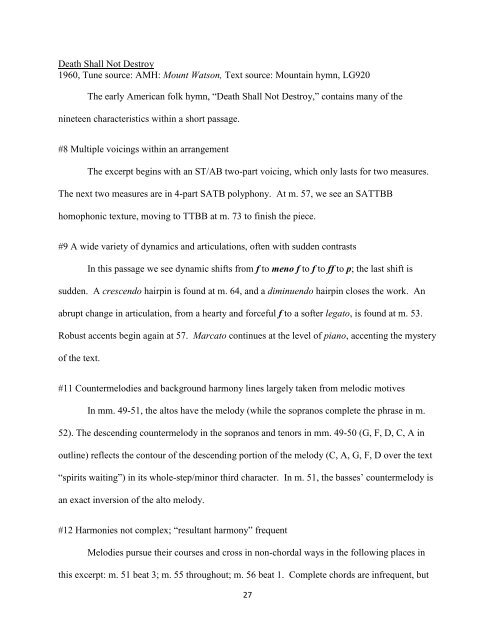THE COLLABORATIVE ARRANGEMENTS OF ALICE PARKER AND ...
THE COLLABORATIVE ARRANGEMENTS OF ALICE PARKER AND ...
THE COLLABORATIVE ARRANGEMENTS OF ALICE PARKER AND ...
You also want an ePaper? Increase the reach of your titles
YUMPU automatically turns print PDFs into web optimized ePapers that Google loves.
Death Shall Not Destroy<br />
1960, Tune source: AMH: Mount Watson, Text source: Mountain hymn, LG920<br />
The early American folk hymn, “Death Shall Not Destroy,” contains many of the<br />
nineteen characteristics within a short passage.<br />
#8 Multiple voicings within an arrangement<br />
The excerpt begins with an ST/AB two-part voicing, which only lasts for two measures.<br />
The next two measures are in 4-part SATB polyphony. At m. 57, we see an SATTBB<br />
homophonic texture, moving to TTBB at m. 73 to finish the piece.<br />
#9 A wide variety of dynamics and articulations, often with sudden contrasts<br />
In this passage we see dynamic shifts from f to meno f to f to ff to p; the last shift is<br />
sudden. A crescendo hairpin is found at m. 64, and a diminuendo hairpin closes the work. An<br />
abrupt change in articulation, from a hearty and forceful f to a softer legato, is found at m. 53.<br />
Robust accents begin again at 57. Marcato continues at the level of piano, accenting the mystery<br />
of the text.<br />
#11 Countermelodies and background harmony lines largely taken from melodic motives<br />
In mm. 49-51, the altos have the melody (while the sopranos complete the phrase in m.<br />
52). The descending countermelody in the sopranos and tenors in mm. 49-50 (G, F, D, C, A in<br />
outline) reflects the contour of the descending portion of the melody (C, A, G, F, D over the text<br />
“spirits waiting”) in its whole-step/minor third character. In m. 51, the basses’ countermelody is<br />
an exact inversion of the alto melody.<br />
#12 Harmonies not complex; “resultant harmony” frequent<br />
Melodies pursue their courses and cross in non-chordal ways in the following places in<br />
this excerpt: m. 51 beat 3; m. 55 throughout; m. 56 beat 1. Complete chords are infrequent, but<br />
27
















